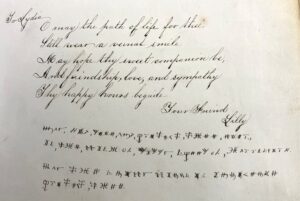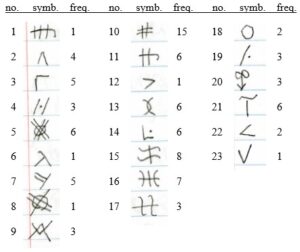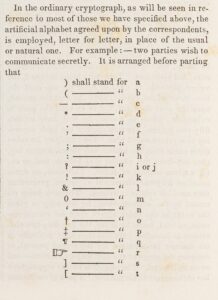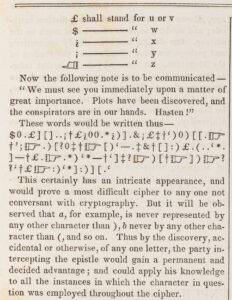The Stubbs Collection at the American Antiquarian Society contains hundreds of friendship albums. Friendship albums usually contain messages to the album owners from friends, family members, and schoolmates. Many messages have a “forget me not” theme, or they may be philosophical or humorous. The contents of friendship albums were not private, in that the albums were circulated by the owner among those who made entries, and in many cases the albums would have been on display for household visitors to read. Some messages are in foreign languages, including Greek, Latin, Hebrew, Arabic, and various Asian languages. While reviewing the albums recently, we noticed coded messages in two of the albums.
The first example is in 17-year-old Mary Boyden’s 1854 album from South Walpole, MA. It contains the following dedication:
A birthday present from her friend Dkaqhcfd, July 27th/54
The person who presented Mary Boyden with her album wrote his name in code, perhaps to preserve a sense of privacy, but it is a code which is easily solved. If we shift each letter by one place in the alphabet, D becomes E, k becomes l, and so forth, yielding the name Elbridge for the album donor. We can determine who Elbridge was by looking at public records. From marriage records, we find that at age 23, Mary Boyden, the daughter of Harvey and Esther Boyden, married E. P. Boyden, a schoolteacher, the son of James and Lucy Boyden on June 3, 1860. Later records confirm that E. P. Boyden was Elbridge Boyden. In other words, the coded name “Dkaqhcfd” represents the person that Mary would marry, six years after the entry was made in her friendship album.
A more complex coded message was found in an 1858 album owned by Lydia Rise of Lebanon, PA. Lydia was 12 years old when she was given the album in 1858, but there is no date on the message itself. The first part of the message is not encoded and reads as follows.
To Lydia
O May the path of life for thee
still wear a vernal smile
May hope thy sweet companion be,
And friendship, love, and sympathy
Thy happy hours beguile.
Your Friend
Lilly
This is a fairly typical friendship-album expression of hope and good wishes. However immediately underneath the “ordinary” message there is an extension of the message written in a code with curious symbols (Figure 1). Some of the symbols look similar to Greek letters or mathematical symbols, but as a whole they do not correspond to any standard alphabet or symbol set.

To solve the code, we start with the assumption that this is a substitution code — that is, we assume that each symbol corresponds to a letter of the Roman alphabet. Next, we assign a number to each symbol in the message, so that we can refer to individual symbols. The symbol numbers are arbitrary, here we assign them according to the order in which a particular symbol first appears in the message. We also note the total number of characters in the coded message (99), the number of distinct symbols (23), and we count the frequency of each symbol, that is, the total number of times a symbol appears in the message. The symbol numbers and their frequencies are given in Table 1.
Since there are 99 characters in the coded message, a symbol’s number frequency is approximately equal to its percent frequency. For example, using Table 1 we see that symbol 1 corresponds to 1% of the characters in the message, symbol 2 appears as 4% of the characters, and so forth. This information is useful because the frequencies with which individual symbols appear can be used in guessing which letter of the Roman alphabet they correspond to.

The frequencies with which particular letters occur in the English language are available from numerous online sources. According to Ref. 1, the ten most frequent letters in order of frequency are: E, T, A, O, N, R, I, S, H, and D. We can use this list to make initial guesses for the symbols in the Lydia Rise album, after ranking the symbols in order of frequency. The results are as follows.
symbol no.: 10 15 16 (5 11 13 14 21)
possible letter: E T A O N R I S
The symbols with numbers in parentheses all have a frequency equal to six, therefore the specific O N R I S assignments are arbitrary.
We can now start to decode the message using this letter assignment. The process can be carried out using pencil and paper, however it is convenient to set up a spreadsheet which automatically populates the coded message with our trial letters. This allows us to make rapid guesses for the letters corresponding to the symbols and immediately see how the message is affected. With the letter assignments given above the message appears as follows:
Examining the message, we notice that the word TAEE appears twice, which may be thee, therefore the symbol 16 should be an H. Also, the last word in the third line may be innocence, which means that symbol 13 should be an I, and symbol 22 should be a C. Making these three changes we get:
In the first line, the fifth word looks like protect, which means symbol 20 is P and symbol 21 should be an R. In the second line, the first word may be is, which means that symbol 14 is S. The word before innocence may be of, which means that symbol 19 is an F. With these changes we get the following:
Now we are getting closer. We can make changes based on the following guesses. The last word in the first line is ever. The third word in the second line is wish and the last word is Harrisburg. (This is a Pennsylvania album.) The phrase in the third line is the snowy wings of innocence. After incorporating these guesses the message appears as follows:
Now we are quite close. Proceeding with a few more guesses we obtain the final message,
May God love and protect thee ever
is the wish of Lilly Speel of Harrisburg.
May the snowy wings of innocence
protect thee.
The coded message is a benediction which is more or less a continuation of the first (unencoded) part of the album entry. Through looking at vital records, we can determine that “Lilly” is Elizabeth Speel, born on April 11, 1847, in Harrisburg, PA. One may wonder why Lilly Speel encoded the second part, since the character of the message does not seem to require privacy. Was this code only used in private communication between Lydia and Lilly? Did other students use the same code? Did Lilly Speel have an album of her own, and did Lydia Rise write a coded message in Lilly’s album? (We do not have Lilly’s album for comparison.) More generally, was the encoded communication between Lilly and Lydia a rare occurrence, or was it common among 19th century friends and correspondents? We can’t address the prevalence of coded messages in friendship albums in general, but they are certainly not common in the Stubbs Collection albums.
A young person might write a coded message to a friend in order to emphasize the special nature of that friendship, as if to say, We can communicate in our own private language because we have a special relationship.
That is, communication with a particular code may have been a sort of textual shibboleth, a unique means of communication distinguishing a small set of friends from the wider community.
Or, the use of codes may have been just for fun, a sort of parlor game. It appears that the topic had a degree of popular interest because Edgar Allen Poe wrote an article about it in Graham’s Magazine in 1841. Titled “A Few Words on Secret Writing,” the article is essentially a tutorial on the writing of coded messages using a variety of techniques. Poe introduces elementary substitution codes using the Roman alphabet, and then he explains that one can use arbitrary non-alphabetic characters, as shown in Fig. 2.


In his example Poe shows how to encode the message which begins,
We must see you immediately upon a matter of great importance.
The encoded message is shown on p. 37 (b), starting with the symbols $0.£][].. and so forth.
A close reading of the encoded message shows that it contains numerous errors. For example, if we decode the first five words of the encrypted message we get:
Wmeust see you xmmedxasely.
Perhaps Poe’s manuscript submission was not clear to the typesetter, or the errors could have occurred if the typesetter struggled with such a peculiar string of symbols. In the five words shown here the typesetting errors were as follows.
(i) The e and m symbols were interchanged in the first and second words, producing Wmeust instead of Wemust.
(ii) The question marks are upside down in the fifth word, turning i into x in the word immediately.
(iii) A right bracket was used instead of a left bracket, turning t into s in the same word.
Revisiting Lilly Speel’s coded message (Figure 1 and Table 1), there are a few coding errors in that case as well. The first involves the symbol used for the letter o. In the first case, as symbol number 5, it is written as a circle with a double cross superimposed. It reappears in symbol 8 with one of the lines in the cross missing, and as symbol 18 with the crosses entirely absent, although in all cases the symbol represents the letter o. The other type of error in Lilly’s message is in the word innocence at the end of the third line, where the last c in the word contains the superposition of two symbols, one being the correct one (symbol 22).
Poe’s example in Figure 2 shows the same type of code as the one used by Lilly Speel and Lydia Rise. The only difference is superficial: whereas Poe used symbols available to a typesetter (such as brackets, an asterisk, and the British pound symbol), Lilly and Lydia used their own invented symbols which were drawn by hand. It is possible that Lilly and Lydia were familiar with Poe’s article in Graham’s Magazine, but the 17-year time delay between the article and the friendship album may make this unlikely. Nonetheless, the general idea of writing coded messages in the middle of the 19th century may have had a degree of cultural currency. The message in the Lydia Rise album may simply be one example out of many.
References:
-
- Herbert S. Zim, Codes and Secret Writing, Scholastic Book Services (New York, 1948).
- Edgar A. Poe, A Few Words on Secret Writing, Graham’s Magazine, Vol. XIX, No. 1, pp. 33-38 (Philadelphia, July 1841). (AAS Catalog Record: http://clarence.mwa.org/Clarence/full-holding.php?bib_id=17055)
Frank Lamelas is a volunteer in the manuscripts department at the American Antiquarian Society.



